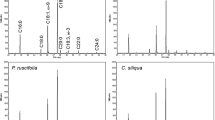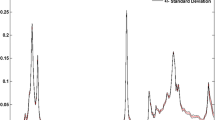Abstract
NMR spectroscopy was used to distinguish pure sunflower lecithin from that blended with soy species, and to quantify the degree of such adulteration. Sample preparation included liquid extraction of lecithin blends and measurement of polar and non-polar fractions using 31P and 1H NMR spectrometry. Several phospholipid species, linolenic acid and stachyose were found to be characteristic for sunflower lecithin authentication. For quantitative analysis, partial least squares regression (PLS) was utilized for modeling NMR data of authentic lecithin samples and in-house prepared blends (n = 80). The models based on phospholipid, fatty acid and saccharide distributions were validated using independent test sets. PLS based on saccharide composition is able to estimate lecithin falsification regarding its vegetable origin with the sensitivity and root mean square error of validation below 1 % w/w and 3.5 % w/w, respectively. Prediction error was improved by modeling the whole lecithin profile (phospholipids, fatty acids, and saccharides). Repeatability and precision expressed in coefficients of variations was estimated to be below 8 %. The developed approach allowed the evaluation of the composition of lecithin blends of unknown soy and sunflower content on the basis of multiple chemical components.





Similar content being viewed by others
References
Scholfield CR (1981) Composition of soybean lecithin. J Am Oil Chem Soc 58:889–892
Krawczyk T (1996) Lecithin: consider the possibilities. Inform 7:1158–1167
Wendel A (2000) Lecithin: the first 150 years part I: From discovery to early commercialization. Inform 11:885–892
Wendel A (2000) Lecithin: the first 150 years Part II: Evolution to a global pharmaceutical industry. Inform 11:992–997
van Nieuwenhuyzen W (1981) The industrial uses of special lecithins. J Am Oil Chem Soc 58:886–888
Pardun H (1989) Pflanzenlecithine—wertvolle Hilfs—und Wirkstoffe? Fat Sci Technol 91:45–58
Pan LG, Noli A, Campana A, Barrera M, Tomas MC, Añón MC (2001) Influence on the processing conditions on degummingprocess in sunflower seed oil. J Am Oil Chem Soc 78:553–554
Marinho CD, Martins FJ, Amaral Júnior AT, Gonçalves LS, dos Santos OJ, Alves DP, Brasileiro BP, Peternelli LA (2014) Genetically modified crops: Brazilian law and overview. Genet Mol Res 13:5221–5240
Elsanhoty RM, Al-Turki AI, Ramadan MF (2013) Prevalence of genetically modified rice, maize, and soy in Saudi food products. Appl Biochem Biotechnol 171:883–899
Palm M, Moneret-Vautrin DA, Kanny G, Denery-Papini S, Frémont S (1999) Food allergy to egg and soy lecithins. Allergy 54:1116–1117
Cabezas DM, Diehl BWK, Tomás MC (2009) Sunflower lecithin: application of a fractionation process with absolute ethanol. J Am Oil Chem Soc 86:189–196
Krüger S, Bürmann L, Morlock GE (2015) Comparison and characterization of soybean and sunflower lecithins used for chocolate production by high-performance thin-layer chromatography with fluorescence detection and electrospray mass spectrometry. J Agric Food Chem 63:2893–2901
Zhou L, Zhao M, Khalil A, Marcic C, Bindler F, Marchioni E (2013) Identification of volatiles from oxidised phosphatidylcholine molecular species using headspace solid-phase microextraction (HS-SPME) and gas chromatography–mass spectrometry (GC-MS). Anal Bioanal Chem 405:9125–9137
Helmerich G, Koehler P (2003) Comparison of methods for the quantitative determination of phospholipids in lecithins and flour improvers. J Agric Food Chem 51:6645–6651
Lee WJ, Weng SH, Su NW (2015) Individual phosphatidylcholine species analysis by RP-HPLC-ELSD for determination of polyenylphosphatidylcholine in lecithins. J Agric Food Chem 63:3851–3858
Jangle RD, Galge RV, Patil VV, Thorat BN (2013) Selective HPLC method development for soy phosphatidylcholine fatty acids and its mass spectrometry. Ind J Pharm Sci 75:339–345
Martiän-Hernaändez C, Beänet S, Marvin-Guy LF (2005) Characterization and quantification of proteins in lecithins. J Agric Food Chem 53:8607–8613
Fernandes GD, Alberici RM, Pereira GG, Cabral EC, Eberlin MN, Barrera-Arellano D (2012) Direct characterization of commercial lecithins by easy ambient sonic-spray ionization mass spectrometry. Food Chem 135:1855–1860
Pati S, Quinto M, Palmisano F, Zambonin PG (2004) Determination of choline in milk, milk powder, and soy lecithin hydrolysates by flow injection analysis and amperometric detection with a choline oxidase based biosensor. J Agric Food Chem 52:4638–4642
Yao L, Jung S (2010) 31P NMR phospholipid profiling of soybean emulsion recovered from aqueous extraction. J Agric Food Chem 58:4866–4872
Diehl BWK (1997) Multinuclear high-resolution magnetic resonance spectroscopy. In: Hamilton RJ (ed) Lipid analysis in oils and fats. Blackie, London, pp 87–135
Diehl BWK (2001) High resolution NMR spectroscopy. Eur J Lipid Sciand Tech 103:830–834
Diehl BWK, Ockels W (1995) Quantitative analysis of phospholipids. In: Cevc G, Paltauf F (eds) Proceedings of the 6th international colloquium phospholipids characterization metabolism and novel biological applications. AOCS, Champaign, pp 29–32
Tomasi G, Savorani F, Engelsen SB (2011) Icoshift: an effective tool for the alignment of chromatographic data. J Chromatogr A 1218:7832–7840
Cordella CBY, Bertrand D (2014) SAISIR: a new general chemometric toolbox. Trends Anal Chem 54:75–82
Wold S, Sjostrom M, Eriksson L (2001) PLS-regression: a basic tool of chemometrics. Chemometr Intell Lab Syst 58:109–113
Monakhova YB, Diehl BW (2015) Combining (1)H NMR spectroscopy and multivariate regression techniques to quantitatively determine falsification of porcine heparin with bovine species. J Pharm Biomed Anal 115:543–551
Simas RC, Catharino RR, Cunha IB, Cabral EC, Barrera-Arellano D, Eberlin MN, Alberici RM (2010) Instantaneous characterization of vegetable oils via TAG and FFA profiles by easy ambient sonic-spray ionization mass spectrometry. Analyst 135:738–744
Alam TM, Alam MK, McIntyre SK, Volk DE, Neerathilingam M, Luxon BA (2009) Investigation of chemometric instrumental transfer methods for high-resolution NMR. Anal Chem 81:4433–4443
Monfreda M, Gobbi L, Grippa A (2012) Blends of olive oil and sunflower oil: characterisation and olive oil quantification using fatty acid composition and chemometric tools. Food Chem 134:2283–2290
Mogollon NG, Ribeiro FA, Lopez MM, Hantao LW, Poppi RJ, Augusto F (2013) Quantitative analysis of biodiesel in blends of biodiesel and conventional diesel by comprehensive two-dimensional gas chromatography and multivariate curve resolution. Anal Chim Acta S796:130–136
Cagliani LR, Pellegrino G, Giugno G, Consonni R (2013) Quantification of coffea arabica and coffea canephora var. robusta in roasted and ground coffee blends. Talanta 106:169–173
Acknowledgment
Y. Monakhova acknowledges funding in the framework of the state contract 4.1708.2014K of the Russian Ministry of Education.
Author information
Authors and Affiliations
Corresponding author
About this article
Cite this article
Monakhova, Y.B., Diehl, B.W.K. Quantitative Analysis of Sunflower Lecithin Adulteration with Soy Species by NMR Spectroscopy and PLS Regression. J Am Oil Chem Soc 93, 27–36 (2016). https://doi.org/10.1007/s11746-015-2753-x
Received:
Revised:
Accepted:
Published:
Issue Date:
DOI: https://doi.org/10.1007/s11746-015-2753-x




